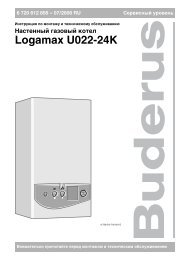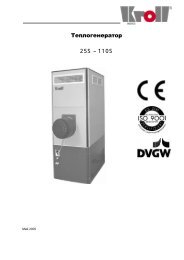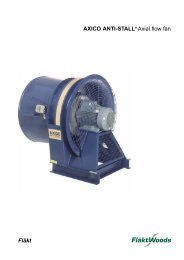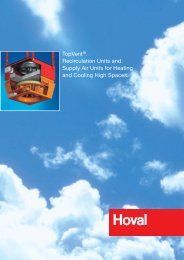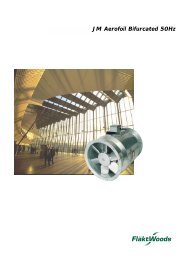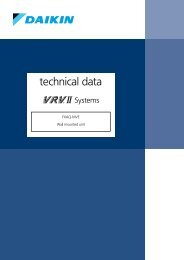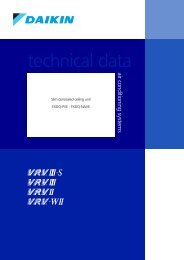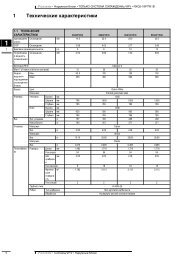Supply air unit, VEKA
Supply air unit, VEKA
Supply air unit, VEKA
You also want an ePaper? Increase the reach of your titles
YUMPU automatically turns print PDFs into web optimized ePapers that Google loves.
<strong>Supply</strong> <strong>air</strong> <strong>unit</strong>, <strong>VEKA</strong><br />
Technical data<br />
Accessories<br />
Electrical heater for mounting in a duct, VEEK<br />
An electrical heater, VEEK, for mounting in a duct<br />
has been developed to heat the supply <strong>air</strong> in a ventilation<br />
system.<br />
The casing is made of aluminium zinc coated<br />
steel sheet with heating elements in stainless<br />
material, EN 1.4541.1.<br />
The electrical heater casing has an <strong>air</strong> gap<br />
insulated heat shield and is provided with a<br />
PG connection.<br />
VEEK is provided with output regulation.<br />
The maximum permissible operating temperature<br />
for outgoing <strong>air</strong> is 40°C, and the ambient<br />
temperature of the heater must not exceed 30° C.<br />
Installed in the heater are two overheating protectors,<br />
one capable of automatic resetting and one<br />
capable of manual resetting. The electrical heater<br />
is available in 9, 15 and 21 KW output variants for<br />
<strong>VEKA</strong> size 20, and in a 24 kW output variant for<br />
<strong>VEKA</strong> size 30. VEEK is available for 3 x 400 V.<br />
IP class 43.<br />
The heater can be mounted in a horizontal or<br />
vertical duct with the connection box to the side.<br />
Mounting with the connection box facing upwards<br />
or downwards is NOT permitted.<br />
The <strong>air</strong> velocity over the front area of the heater<br />
must not be less than 1.5 m/s.<br />
VEEK-aa-bb-c-d-e-4<br />
The VEEK <strong>air</strong> heater with a thyristor has the<br />
necessary relay switches preinstalled. The output<br />
is regulated from an external control signal 0 - 10<br />
V DC. The electronic temperature regulator controls<br />
the output with so-called time-proportional<br />
regulation (Pulse/Pause method). This gives very<br />
accurate temperature regulation.<br />
The temperature is always finely regulated,<br />
however, by the electronic Pulse/Pause control.<br />
The control equipment has an alarm output with<br />
potential-free contact, which indicates tripped<br />
overheating protection.<br />
The <strong>air</strong> heater is supplied separately from an<br />
external electrical control <strong>unit</strong> with a power cable<br />
and a control circuit.<br />
The control circuit must be sealed against the<br />
fan/flow. This also applies for devices with a builtin<br />
electrical, control and regulation <strong>unit</strong>.<br />
Size Output variant Connection Power output External dimension Weight Min <strong>air</strong> flow Max power<br />
aa bb mm kW mm (BxHxL) kg m 3 /s consumption at 400V AC<br />
20 11 600x250 9 769x288x800 30 0,225 13<br />
20 12 600x250 15 769x288x800 35 0,225 22<br />
20 13 600x250 21 769x288x800 40 0,225 30<br />
30 23 900x250 24 1069x288x800 48 0,338 35<br />
Sound attenuator for installation in a duct, VELD<br />
Rectangular sound attenuator VELD consists of a<br />
casing made of hot-dip galvanized steel sheet and<br />
built-in baffles.<br />
The sound attenuator has an uninsulated casing.<br />
VELD-aa-b-1<br />
Size Connection Length Weight<br />
aa mm mm kg<br />
20 600x250 950 16<br />
20 600x250 1250 20<br />
30 900x250 950 21<br />
30 900x250 1250 28<br />
Duct connections are provided with a PG connection.<br />
The baffle has a filling of glass wool for damping<br />
the fan and orifice noise to a ventilated space.<br />
The sound attenuators provide high damping in<br />
the low frequency ranges and have damping elements<br />
positioned on the largest side of the casing.<br />
Fläkt Woods 8513 GB 2008.07 16<br />
Subject to alteration.



